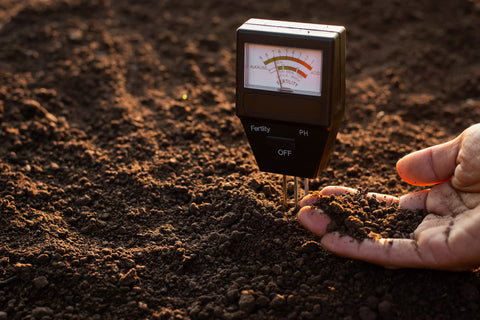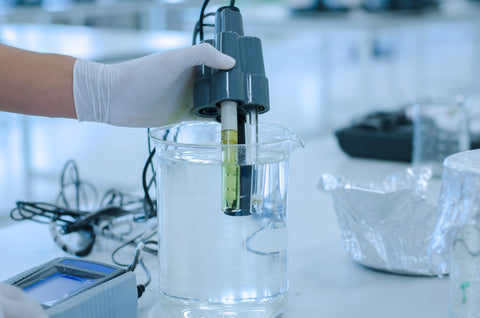
Measuring Low Acid Coffee
What does it mean for a coffee to be low in acid? Since there is no certifying agency to verify what constitutes a coffee that is low acid, there can be a wide range of coffees that are "stated" to be low in acid and are only marginally less acidic. How low in acidity is low acid coffee? I will answer that question in this post.
Each low acid coffee should be scored by pH. If they are not scored by pH, I suggest you keep looking.
Simplicity and Objectivity of pH Measurements
Before I get into the details of the pH scale, you should know pH measurements are objective, not subjective. Think of a tape measure. When it measures the length of something, that is the true length. It is a great tool to use for accessing the acidity of coffee beans, because the scale is objective, just like the tape measure.
In this post, I will address the quantitative aspect. Acidity levels in coffee are typically measured with two different methods.
- pH Test
- HPLC Analysis
pH Scale of Coffee
The first and most popular method is by measuring the pH level of a coffee after it has been brewed. In case you are ever on Jeopardy, The pH scale, which stands for the possibility of hydrogen, is the scale used to report how or acidic or basic a substance might be.
The pH is typically measured in three ways. By litmus paper, by pH meter, or lab analysis. Measuring low acid coffee is best done by this pH.
pH Meter
A common method is to use a pH meter, which is a device that measures the acidity or alkalinity of a solution. pH meters are generally accurate to within 0.1 to .2 pH units (10% to 20%). You can find pH meters for sale online.
The number one problem with using pH testers that I have found is calibration and inconsistent scoring. All the pH meters that I have used require a control solution to be administered before you begin and sometime between tests.
If a pH meter has not been used for a while, you will have to calibrate the unit. It is not hard, but it is a hassle. The accuracy is pretty good for a non-commercial test, but human error can affect the measurements.

Test Strips
The most common method is to use pH test strips. Test strips are paper strips that change color when they come into contact with a solution. pH test strips are less accurate than pH meters. However, test strips are much less expensive and less of a hassle.

Laboratory analysis.
The best method of getting the most accurate and consistent score is laboratory analysis. Plus, in the controlled environment of a lab with professional testing protocols and highly sophisticated equipment, lab analysis will yield a more accurate and consistent score.
Most importantly, the laboratory is done by an independent third party, so the analysis is highly accurate equipment and not subject to "thumbs on the scale" by the interested party.
Yes, it costs more to do, but we are talking not only about people's money but most importantly, their health.

Trust But Verify the Low Acid Coffee Score
- First: as a consumer, you should not have to test anything. If the coffee company is selling low acid coffee, they should have already tested it.
- Second: those results should be done by a 3rd independent lab, guaranteeing the most accurate results, but also eliminating any possibility of fudging the numbers.
- Third: The roaster should be transparent with the numbers, if the 3rd party report is not posted, move on. It's your health!
High-Performance Liquid Chromatography for Testing Coffee.
The second method of determining acid levels in coffee would be through the use of High-Performance Liquid Chromatography (HPLC). The HPLC is an instrument used to provide an analysis of the chemical composition of a given substance. In the case of coffee, the HPLC analysis can isolate for quantifying the amount of Chlorogenic acid in a coffee bean.
This process is much more expensive and is great for assessing the presence of individual acids. However, this measurement will not give you the overall acidity level of the cup.
pH Measurements vs HPLC Outputs.
The pH method is used to assess the acidity of a liquid such as a brewed cup of coffee. The HPLC analysis uses the dry weight of the chemical substances, the acids that are in the coffee bean, which might be expressed in grams or milligrams.
The pH Scale Explained.
By the numbers, a given liquid will return a value on the pH scale between 1 to 14. On the pH scale, 7 is considered to be neutral. Any liquid less than 7 is considered acidic and any liquid over 7 is rated basic. Battery acid would measure 1 on the pH scale being very acidic, and ammonia being a basic mixture would rate around 12. Water is 7.
The pH of Coffee.
Most coffees will measure in the range of 4.5 to 4.9 on the pH scale. The non-specialty grade coffees you will find in a can at the supermarket are very acidic measuring closer to 4.5. Most specialty coffee today, including the national coffee chains, score around 4.8 to 4.9, which still retains a significant level of Chlorogenic acid.
Regular coffee verses Low Acid Coffee.
Low acids coffees should be closer to 6.0 on the pH scale. The pH scale is logarithmic. Logarithmic means that a change in 1 unit of pH is expressed by a ten-fold increase or decrease in percentage. To make this more clear, let’s look at an example of two different coffees.
pH Scale Examples:
- Coffee #1: National Brand: pH 5.0
- Coffee #2: Mavericks House: pH 5.8
Using the pH, which is expressed on a logarithmic scale (PH+ -log[H+]), coffee #2, Mavericks House, would be 80% lower in acid than Coffee #1, National Brand.
So what might appear as small differences in the pH at .8 is very mathematical relevant. For sensitive coffee drinkers that might be the difference between being able to drink and enjoy a cup of coffee versus not being able to drink a cup of coffee at all.
HPLC Analysis of Coffee.
For the HPLC method, chemical compounds within the coffee bean can be isolated and analyzed. In the case of studying acidity in coffee, we are discussing the levels of Chlorogenic acid present in a coffee bean. Chlorogenic acid is an organic acid compound that exists in relatively high concentrations in coffee and is arranged at the molecular level in nearly a dozen configurations. If you are ever on Jeopardy, these chemical configurations are called Isomers, which simply means the same.
These isomers are all still classified as Chlorogenic acid, they are just arranged differently. The arraignments impact how each of these isomers is affected by heat during the roast. See more article Is Coffee An Acid Everything You Should Know About Coffee Acidity for more on volatile an non volatile acids.

The HPLC analysis, can not only tell us which organic acids such as Malic acid or Chlorogenic acid are in the coffee, but it can also detail which specific Chlorogenic acid configurations (isomers) are present and how they were affected by the heat during the roast.
This can be important for several reasons. Chlorogenic acid, specifically caffeloquinc acids can affect people with sensitive stomachs. Additionally, this acid can also be associated with bitterness and other unpleasant flavor notes in coffee.
While the HPLC measurement can not give me the pH of the cup, it gives me a profile of the acids. So when I developed the profile to slow roast the coffee, I know the coffee has 8.5% of acids by weight and 4% are Chlorogenic and Caffeloquinc acids, which are nonvolatile, so I will adjust the heat and duration of roast accordingly.
This information helps me develop a roast profile to not only minimize acidity but also provide a smoother and better-tasting coffee, which incidentally are both hallmarks of slow roasting.
-Ryan
Don DeMaio
Fascinating. I ordered two different “low-acid” coffees. The first gave me no problems. With the second brand, I only took one swig and instantly started getting a stomach ache. Both brands advertised that they were low-acid but neither would specify what their concept of low-acid was. Where can I buy the test strips you mentioned?